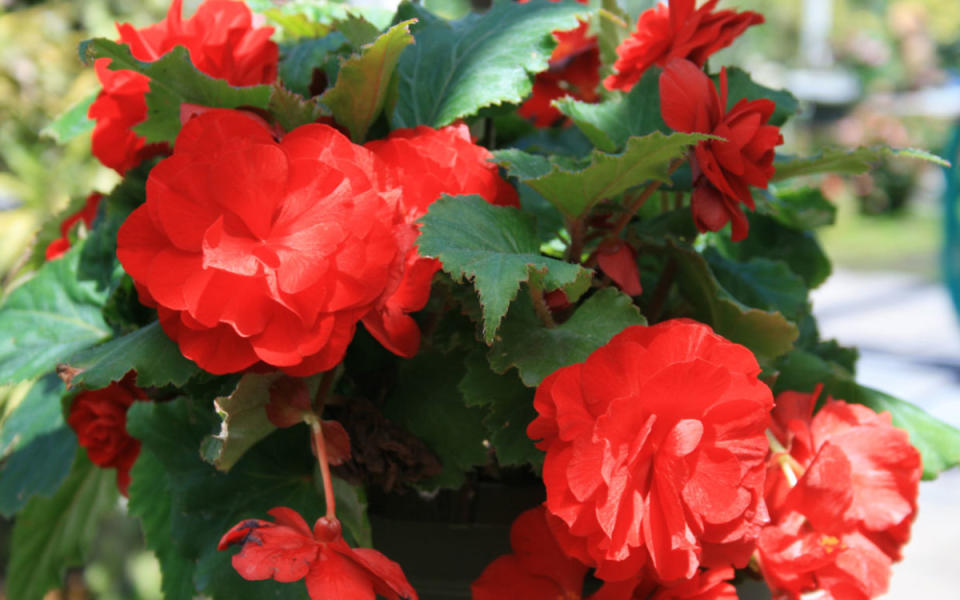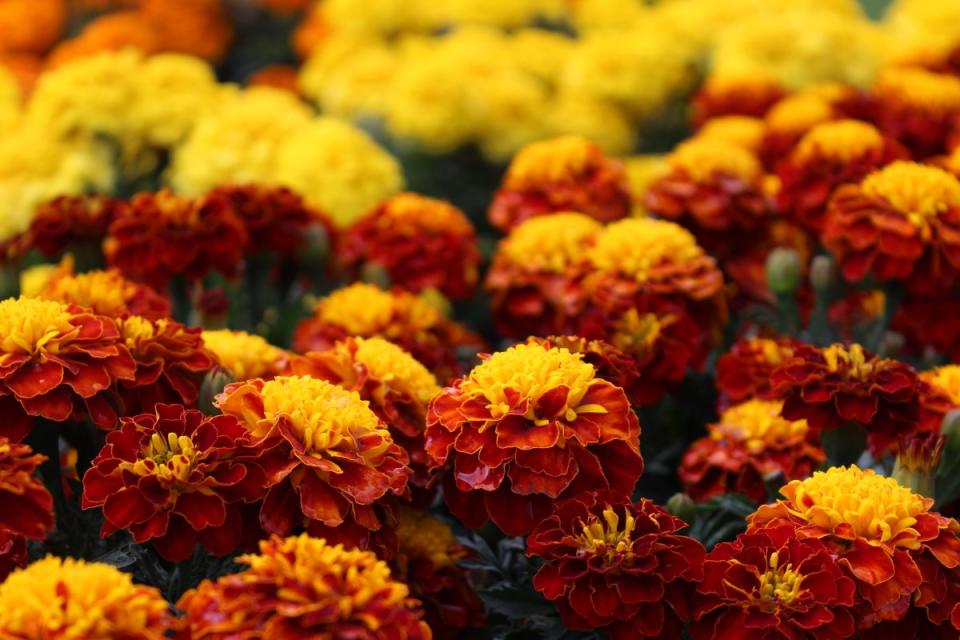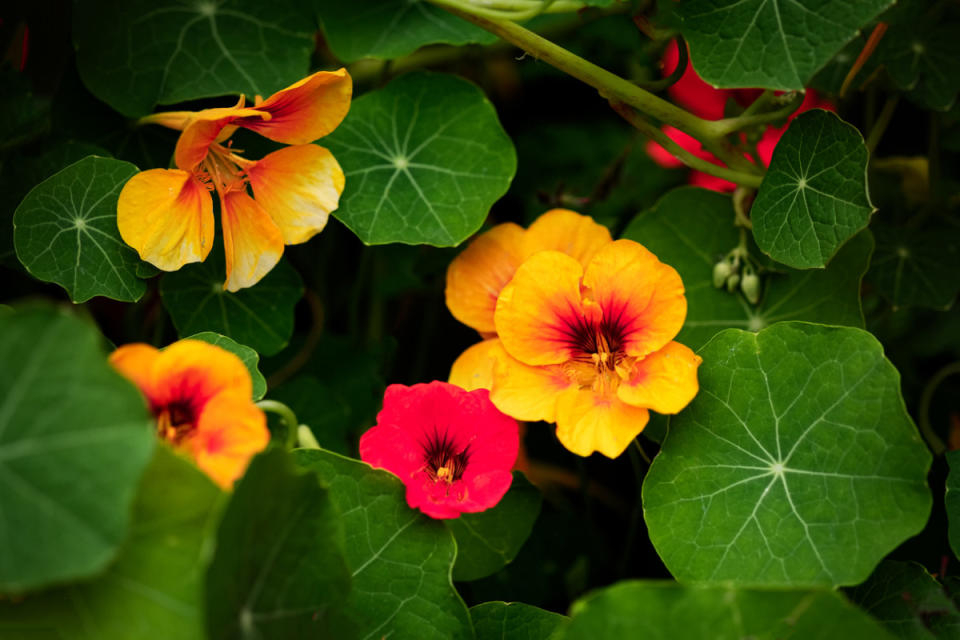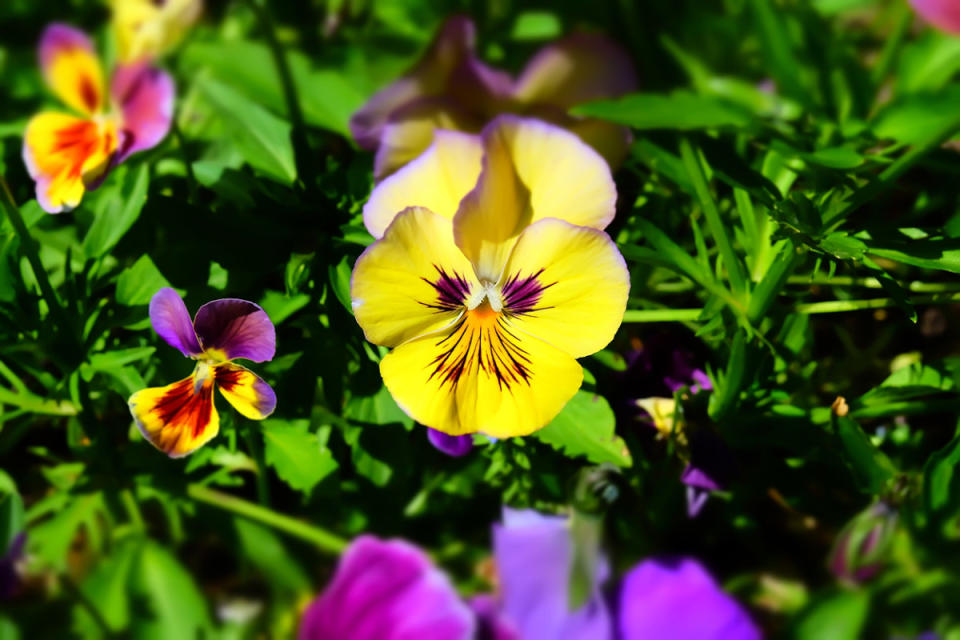16 Different Types of Edible Flowers You Can Add to Your Garden

Edible flowers on a plate to eat
"Spring" is synonymous with "gardening" for many people with green thumbs. And while some gardens are coveted for their bright and beautiful colors, others are especially appreciated thanks to utilizing edible flowers. That's right, some lovely blooms aren't just appealing because of their appearance—they can add extra taste, texture and nutrients to your meals as well.
Sam Corfield, AKA "The Hairy Horticulturist" on Instagram, shares with Parade some of the top flowers to eat, as well as tips on how to grow and use them.
After all, "You want to grow edible flowers that not only look great but also attract lots of beneficial insects into your growing space," Corfield tells us.
And while there are plenty of benefits that come with including this greenery in your regular garden, it's wise to be a little cautious with each one initially. "As with all new ingredients that you've never had, give each one a little taste before cooking with them as all flowers can give certain people an allergic reaction," he explains.
Whether you have a huge garden, raised beds or even containers, there is something in this list that can be grown in each. Wondering what flowers are edible? All you have to do is sit back and keep reading to get ideas on what to add to your garden (or your plate).
Related: The Month of May Has 2 Birth Flowers to Choose From—Here's What They Symbolize
16 Edible Flowers
1. Anise Hyssop
This purple beauty belongs to the mint family. Anise Hyssop has fuzzy-looking flowers, that upon a closer look are composed of tons of teeny, tiny bell-shaped blooms. They love full sun, can grow quite tall (3-5ft.) and have a flowering period from mid-summer through fall. They have a long history of medicinal use.
Both the leaves and flowers are edible. You can snip up the leaves and add them to salads or jelly, or dry them for teas. Incorporate them into anything you think could use a bit of licorice flavor, like cookies or muffins.
Corfield's Tips: It's a lovely self-seeding perennial that has a sweet flower with a hint of licorice. Best used in desserts.
Related: 40 Best Spring Flowers to Beautify Your Backyard, According to Gardening Experts

Julie Bawden-Davis
2. Begonia
Because it's easy to grow annuals, they make fantastic additions to containers. Begonias come in quite a few colors, including pink, white, orange and red. They do well in indirect sun or partial shade, and just need some regular watering.
Fun fact about the Begonia genus: they have over 2,000 varieties due to the way that they can hybridize each other. Leaves, stems and flowers are edible on begonias, and can have a citrusy taste. They would be an especially good addition to salads.
Corfield's Tips: Tuberous begonia flowers have a bit of a sour taste due to oxalic acid.
3. Chamomile
There are a couple of types of Chamomile: German and Roman. Both bloom small (daisy-like) and are very fragrant flowers. The Roman type is the one used for tea and medicinal purposes. The blooms can be dried or used fresh in teas. Chamomile, when fresh, has a flavor similar to an apple, so it would be a great addition to dishes like oatmeal.
Corfield's Tips: Chamomile is a potent herb that is mainly used for medicinal purposes, but you can enjoy the flowers in a dish. Try growing the plants in a lawn, it's their natural habitat.
Related: Create Your Own Butterfly Paradise With These 35 Plants and Flowers That Attract Butterflies
4. Chicory
Chicory are cute little daisy-like flowers that look best when grown in a group. They have underwhelming leaves, and the flowers open individually along a 3-5 ft. stem.
Chicory roots are a popular caffeine-free coffee substitute and have additional prebiotic benefits because of their high inulin content. Even though chicory leaves are bitter (but not any more so than spinach), they could be added to your salad.
Corfield's Tips: This is the wild plant—not the cultivated variety. They have small blue flowers that don't have much flavor but look great.
5. Dandelions
Dandelions aren't exactly a flower that anyone really plants but are pretty much everywhere. So, if you can't beat them, then enjoy them. They are loaded with tons of nutrients and can be utilized in many different ways.
The leaves are a great addition to salads, the flowers can be used in making wine and jelly, while the root is sometimes used as a coffee substitute.
Corfield's Tips: They're not for everyone, as they can cause heartburn. It's probably best not to grow them in your garden as they can be invasive, but many of us have them growing wild at home anyway.
Related: What Is Your Birth Flower? Find Out the Meaning Behind the Blooms for Each Month
6. Echinacea (Cone Flowers)
Rich in antioxidants that may support your immunity, echinacea, also known as cone flowers, will make a fantastic edible addition to your gardens. As perennials in the daisy family, echinacea have a mounded center with petals that droop downward (with purple being the most common color). Every part of the plant is edible, with the most popular use being used in tea and tinctures.
Corfield's Tips: This flower is easy to grow in the garden and a favorite with the bees.
7. Garlic Chives
Garlic chives are a perennial herb with delectable greens and pretty clusters of white flowers growing from stems. This edible delight can be harvested anytime during its growth cycle as the greens and flowers are both enjoyable.
Corfield's Tips: It's best to buy the plants rather than seeds. Garlic chives are not only a great herb but the flowers taste and look amazing. Try frying the flowers!
Related: ‘Wait, What Is That?’ 12 Best Plant Identification Apps That Tell You What’s Growing in Your Yard or Along the Trail
8. Hibiscus
Related to cotton and okra through the Mallow family, hibiscus is known for its abundant and gorgeous trumpet-shaped flowers. They are perfectly edible too! The stems, flowers and calyxes (also known as fruit, or the fused sepals attached to the stem) are used in many teas, sauces and jams.
Corfield's Tips: You've probably enjoyed them in an alcoholic beverage, but they can also be eaten raw, straight from the plant. There is a slightly tart flavor to them as well.
9. Jasmine
Planting jasmine in your garden is sure to give a scent boost, but did you know that you can use them to make your new favorite tea too? Jasmine is easy to grow as it only needs partial-to-full sun and minimal care. The flowers come in a few colors: white, pink and yellow.
Not all types of jasmine are edible, so always do your homework. Three of the most common types to use are Jasminum officianale, Jasminum sambac and Jasminum grandiflorum.
Corfield's Tips: Jasmine is a nice climber to have in any garden but the flowers are bitter, so it's best not to cover a dish/salad with lots of them.
Related: What Is Your State Flower? Your Guide to All 50 Blooms from Alabama to Wyoming
10. Lavender
Lavender can grow anywhere from 1-3 ft. tall and is a bushy perennial sprouting stalks of tiny bluish-purple flowers. It is the oils in the flowers themselves that give way to the herb's spectacular fragrance.
Royal velvet and Provence varieties are classified to be culinary lavender and are perfect for cooking. They have reduced oils in the plants that make whatever you are using it in less perfume-smelling. The next time you are feeling a bit ambitious and want to try something new, lavender is great in beverages like lemonade.
Corfield's Tips: It's best used in small quantities if it's going into food (mainly desserts). Lavender is a very pretty perennial that needs free draining soil and attracts lots of bees to your garden.
11. Lilacs
Lilacs are beautiful plants in the olive family, and all varieties are safe to eat. They are huge bee attractors and can fill your space with a strong recognizable scent, as well as add a hint of floral flavor to your dishes. Lilacs can be used to make lilac sugar and simple syrups.
Corfield's Tips: Only the flower is edible and it is best to remove any stem from it. Lilacs have a nice aroma but not that much flavor.
Related: 101 Creative Names for Your Houseplants—AKA Your Sweet, Precious, Angelic Plant Babies

Unsplash
12. Marigolds
Marigolds are happy, low-maintenance flowers, once they're established. They need very little care, except for deadheading, and are nonstop bloomers beginning in early summer, trailing all the way into fall.
You can use marigolds fresh from the garden, or infuse them into your dishes. If you are looking for a hint of pepper and citrus, marigolds are just your flower.
Corfield's Tips: They smell great and are perfect for a greenhouse or indoor growing space. They have lots of little petals if you’re not so keen on eating huge flowers.

iStock
13. Nasturtium
Fast and easy to grow, the nasturtium actually do well with a little bit of neglect. They come in bushy, climbing and trailing varieties that produce hot, bright flowers.
"They come in some pretty funky varieties," Corfield explains. "And they distract pests away from your brassicas like cabbages, cauliflowers, kale, etc."
Corfield's Tips: Peppery and prolific, they're probably the easiest flowers to grow, along with the best taste. Try creating capers by brining the seed pods.
Related: What Does the Lotus Flower Symbolize, Exactly? Experts Reveal Its Significance

iStock
14. Pansies
If you've wondered, "Are pansies edible?"—the answer is yes! Pansies are perfect for your containers or window boxes. They come in every color imaginable and have centers that mimic upturned "faces." They can be found blooming mostly during cooler weather seasons like spring and fall. Edible and pretty, feel free to add pansies to your salads, cakes and drinks.
Corfield's Tips: Pansies are commonly used by restaurants. You may want to buy the plants in spring rather than sowing them from seed. They have little taste but give the "wow factor" to any dish.
15. Roses
Roses are the very symbol of love and the mainstay of many gardens. Before planting any roses, make sure to study up on the variety and its care tips. Roses can be easy or very difficult to cultivate—it just depends on the kind you are planting.
You can snip the rose hip (the fruit bulb left after the flower petals fall) and make tea with it. The petals are also good for simple syrups or jams—just make sure that you are not using flowers that you may have sprayed with chemicals.
Corfield's Tips: Roses are not very strong on flavor unless you stuff a whole flower in your mouth. It's a perennial plant, so you want it somewhere in your growing space where it won't get its roots disturbed with too much cultivation.
Related: What Do Flower Tattoos Symbolize, Exactly? Plus, the Prettiest, Daintiest Floral Tattoo Designs To See
16. Sunflowers
Each year, you will have to plant new sunflowers, but they are easy to grow and have so many benefits to keeping them in your garden. They can be anywhere from 3-6 inches across, with petals that flow out from the large, disked center. The petals, leaves and sprouts are all edible.
Corfield's Tips: The petals are especially tasty. This is a great flower for kids to grow at home, and is good for insects and birds.
Next: Why Are Poppies Used for Memorial Day? Here’s What They Mean
Source
Sam Corfield, AKA "The Hairy Horticulturist" on Instagram

 Yahoo Lifestyle
Yahoo Lifestyle 












